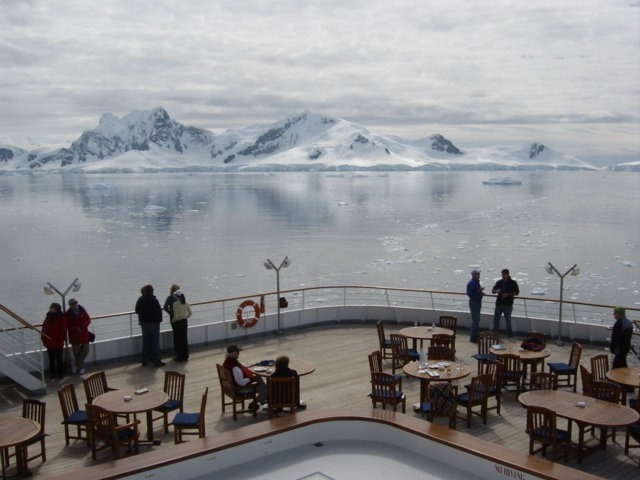Dr Stanley Khoo, TMA member
Travel Medicine Centre Perth
The fresh sea air, the relaxing motion of the ocean, the high staff to passenger ratio, these are some of the many factors that have attracted people to cruise travel. Some destinations such as the Arctic and the Antarctic can only be accessible by boat, and sometimes a cruise ship with its remarkable facilities is the destination itself; a miniature city of restaurants, cinemas, concerts, casinos, night clubs and swimming pools, with a plethora of entertainment opportunities and unlimited food and drink.
A quick scan through past years of this blog show many members of Travel Medicine Alliance have themselves enjoyed cruising or have been part of the staff providing care and hospitality on cruises.
Myself, I have had the opportunity to be a cruise doctor on a large passenger ship in the South Pacific (where I had the privilege of being on the first cruise where no-one had died in the past 3 months!) and on a more intimate icebreaker in Antarctica, where happily as the doctor I was required to accompany the passengers on the most adventurous excursions, medical kit in tow.
How popular are cruises?
According to the Cruise Lines International Association, in 2018, the year in which they collated their last set of firm statistics, 28 million passengers went on a cruise, increasing to an estimated 30 million in 2019, (and further estimations of 32 million people cruising through 2020 before Covid-19 put a complete halt to the industry).
People from North America disproportionately provide half the cruise passengers in the world, but Aussies are also avid cruisers, with 1.35 million of us cruising in 2018, meaning that we are the country providing the 5thhighest number of cruise passengers.
However, since February 2020, cruise ships have been a hotbed of Covid-19 infection, with their crowded environments, and cosmopolitan passengers and crew leading to higher risks and rapid spread of this and other infections.
The Diamond Princess ship, quarantined in Japan, was the first recorded ship to have a major Covid-19 outbreak, with over 700 cases. Several Australians were affected, with 14 deaths recorded, including the first Australian to die after contracting Covid-19.
As of May 2020, over 40 cruise vessels have had confirmed Covid-19 cases, but there are many other ships who were active earlier in the year without any documented cases. The dubious distinction of having the largest number of cases and deaths from Covid-19 on a cruise ship has unfortunately been aboard the Ruby Princess, a vessel that docked in NSW in March with great controversy. It has now had over 852 cases and 22 deaths. 1 in 200 people of the passengers and crew on this cruise have died from Covid-19, and the Ruby Princess currently accounts for over 10% of all the cases in Australia and for 20% of all the deaths from Covid-19 in Australia.
Where to from here?
There is a current ban on overseas travel for Australian citizens by the Australian government, to limit the spread of Covid-19. Exceptions are for business travel, aid assistance, and for compassionate reasons. Despite this, many cruise addicts are already booking their next cruise, with the industry opening bookings for the latter half of 2020.
In May 2020, Simon Birmingham, the tourism minister, has urged Australians not to book holidays that are currently banned. “There are no guarantees about when any of the activities will restart,” he told the ABC, specifically referencing international cruise ships.
The cruise ship industry will need to take large measures to regain the trust of passengers and crew, and have started to promote the steps they are taking to safeguard cruises in the future.
Promulgated actions include increased screening of passengers and crew, both before they are allowed on board and also while onboard, application of social distancing such as staggered mealtimes, increased sanitation, and larger medical facilities with greater numbers of medical staff on board. Other measures mentioned include decreasing the number of passengers per ship, crew members being required to wear personal protective equipment, and limiting travel to local ports.
If these measures make you sufficiently comfortable to book a cruise, I highly recommend a visit to your travel medicine provider or regular GP to optimise your health before travelling and update recommended vaccines such as influenza, pneumonia, measles/mumps/rubella, and diphtheria/tetanus/whooping cough vaccines. Also, remember to get the best insurance cover that you can find!
Read more
https://www.smartraveller.gov.au/COVID-19-australian-travellers
https://en.wikipedia.org/wiki/COVID-19_pandemic_on_cruise_ships
https://www.statista.com/statistics/287111/cruise-passengers-by-source-country/
https://www.maritime-executive.com/article/28-5-million-passengers-took-a-cruise-in-2018
https://www.cruising.org.au/Regulatory/COVID-19
https://wwwnc.cdc.gov/travel/page/cruise-ship
PS this article is worth a look
ABSTRACT
We describe what we believe is the first instance of complete COVID-19 testing of all passengers and crew on an isolated cruise ship during the current COVID-19 pandemic. Of the 217 passengers and crew on board, 128 tested positive for COVID-19 on reverse transcription–PCR (59%). Of the COVID-19-positive patients, 19% (24) were symptomatic; 6.2% (8) required medical evacuation; 3.1% (4) were intubated and ventilated; and the mortality was 0.8% (1). The majority of COVID-19-positive patients were asymptomatic (81%, 104 patients). We conclude that the prevalence of COVID-19 on affected cruise ships is likely to be significantly underestimated, and strategies are needed to assess and monitor all passengers to prevent community transmission after disembarkation.
https://thorax.bmj.com/content/early/2020/05/27/thoraxjnl-2020-215091
